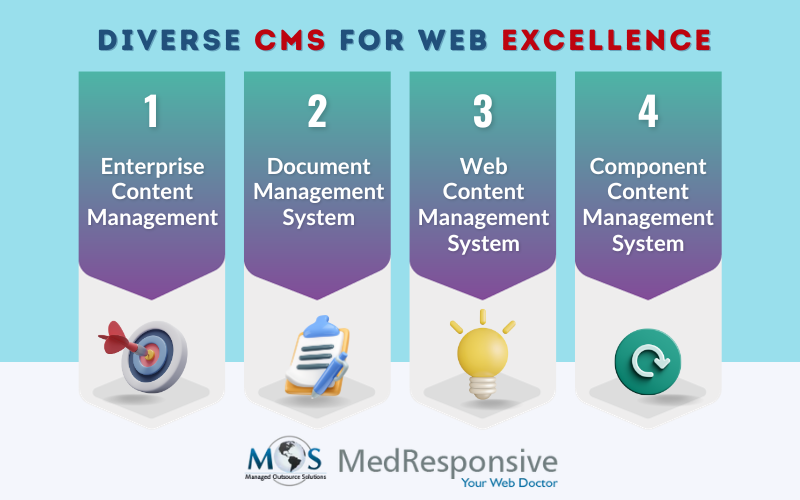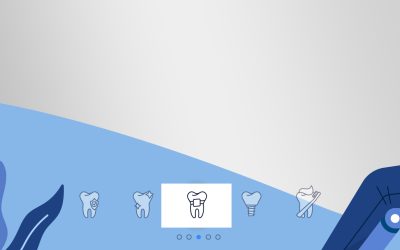Content Management Systems (CMS) have become essential tools in the constantly changing field of web design and development, transforming the process of creating, maintaining, and updating websites. A content management system (CMS) is the foundation of a website. It offers an intuitive user interface that makes it possible for people and organizations to publish, update, and arrange material without requiring a high level of technical knowledge. CMS platforms, when combined with the knowhow of organic SEO services, open up opportunities for websites that are not only functional but also aesthetically pleasing and user-focused, which helps businesses succeed.
Different Types of CMS in Web Design and Development
- Enterprise Content Management (ECM): A platform that makes it possible to handle both structured and unstructured data inside an organization is called an enterprise content management (ECM) system. This indicates that it manages files including web page content, photos, videos, and multimedia assets in addition to documents. An ECM system is a sophisticated automated system that consists of software and a number of tools and tactics for organizing, storing, and distributing content to the appropriate audiences.
- Document Management System (DMS): An ECMS is more sophisticated and well-rounded than a document management system (DMS), which handles the creation, review, and collaboration of simpler documents. It manages documents in conventional formats like Word, Excel, and PDF.
- Web Content Management System (WCMS): An ECM and a web content management system (WCMS) are comparable, but WCMSs were designed with web content in mind. Without the need for programming language skills, a WCMS’s publishing tool enables users to create and manage content for websites, including product pages.
- Component Content Management System (CCMS): Users can manage digital content at the component level with the help of a component content management system (CCMS). A component is an individual piece of content, like a word, paragraph, image, or video. A content component management system (CCMS) differs from a conventional content management system (CMS) in that it allows you to manage content components rather than individual pages.
How Does a Content Management System Function?
A CMS, as previously indicated, is a piece of software that lets you generate and edit digital material. There are two parts to this software application:
- Content Management Application (CMA) is an interface that enables content creators to add, edit, publish, or remove content from a website without the requirement for coding knowledge
- A content delivery application (CDA) is a website’s backend that makes content management and delivery easier by exposing user-generated content to website visitors.
Here is how to use a CMS:
- Select a CMS: Examine your CMS choices and consider the expected results. Distinct platforms have distinct advantages, ranging from an intuitive user interface to sophisticated search features and multilingual support. The CMS that best suits the demands and specifications of your website is the appropriate one.
- Select a Domain Name: Select a domain name for your online presence. On GoDaddy, you may peruse the available names and buy a domain name for as little as $1. Make sure the name you select is memorable, pronounceable, and appropriate for the brand.
- Invest in Web Hosting: Select a hosting company according to the features they supply and a price range that fits your budget. Bluehost and HostGator are two of the most well-known hosting companies.
- Set Up The CMS: The CMS installation process comes next. Depending on the platform you select, this phase may change, but most CMS have preset installation procedures, so it is usually easy to set up and takes little time.
- Install Plugins: The next step is to install plugins, such as an SEO tool or a form-creation plugin, to expand the functionality of your website. Depending on what your objectives are, you can select between premium and free plugins.
- Personalize Your Web Page: Choose from a variety of premium and free themes to develop a custom website design, or have a web designer construct one for you, if you want a one-of-a-kind online presence for your business.
- Upload Content: Uploading your content is the last step. Pre-designed content pages are typically included in templates as drafts that you may modify and replace with your own information. Additionally, you can design your own pages and content kinds.
Advantages of Using CMS
- Does Not Need Coding Experience: The fact that a content management system (CMS) doesn’t require coding knowledge makes it incredibly user-friendly. Even if you’re not good at web design and programming, you can create a website page by page with a content management system (CMS). Making pages, adding content, changing the look, and more is simple.
- Encourages Simple Collaboration: A CMS makes it possible for several people to work together on projects and use the system at the same time. This implies that while a developer is working on security methods, another user may be producing or changing content.
- Provides Built-in Functions: A content management system (CMS) also offers a plethora of built-in features that you can incorporate into your website to enhance its operation and optimize the content. Installing SEO plugins, for instance, may guarantee that the material on your website is completely search engine optimized. You can install SEOPress or All in One SEO if you’re using WordPress.
- Permits Several Users to Access: You can set up accounts for as many people as necessary with a content management system. Each user only needs to create their own account in order to access the CMS and manage or update material.
- Permits Content Planning: Without any technical knowledge, scheduling material is simple when you utilize a CMS. You can set up blog posts, landing pages, emails, and more to be published or sent at specific times with just a few clicks.
- Delivers Real-Time Updates: You don’t need a developer to update your CMS website; you can do it yourself with ease. You can alter anything on your own, such as changing a picture or revamping the website. Simply sign in, navigate to your dashboard, and modify or amend any website on the internet.
Planning to use AI for your content? Read our blog about AI for content creation.
CMS is a powerful and adaptable platform that gives people and companies the key to establishing an engaging online presence. With the extensive knowledge of user experience, design, and technical subtleties, web development companies take CMS-driven websites above and beyond basic functionality.
Enhance your online presence with the power of CMS.





